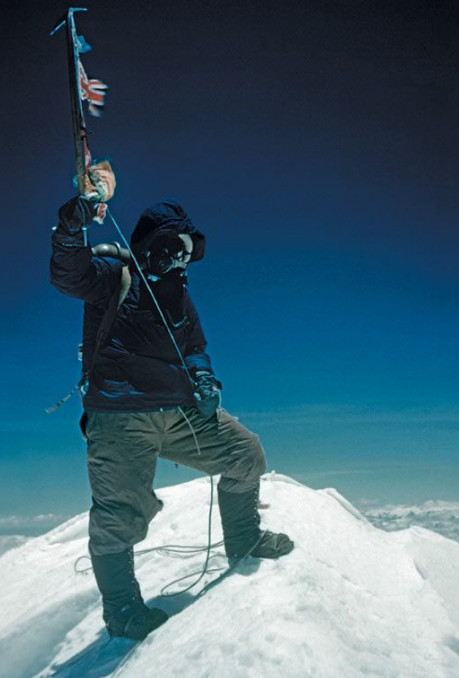What’s wrong with this picture?
The picture shown below is claimed to be a photograph of Sherpa Tenzing on the summit of Mount Everest. Famously, it is the only image that offers proof that, on 29th May, 1953, he and Edmund Hillary reached the apex of the highest mountain on the face of the planet. Yes, reader: the only proof.
It doesn’t matter if there are supposed to be other photographs in existence (try and find them as one might) recording a view “looking down the mountain” supposedly taken by Hillary “to document that the ascent was not faked”, this one image is the only proof that Hillary took those photos at that time. In other words, the demonstration that Hillary produced so-called evidence of his accomplishment subsists in (depends upon) the verification that he conquered Everest. Therefore, this one image is the only proof that a feat constituting the Giant Leap for Mankind of its time (the conquest of Everest is exactly symbolically akin to “stepping on the Moon”) had been achieved.
But there are a number of things terribly wrong with the image, and these are: i) the climber featuring in the image cannot be identified categorically; ii) it is not part of a pair of images to show the identity of the two people who made the ascent (or even, actually, that two people were involved – as unintuitive as that might sound); iii) it does not prove the climber in the context of the narrative – a thing that would have been easy to do given other landmark peaks scattered liberally in close proximity to the location supposedly shown; and related to that: iv) the positioning of the climber in relation to the cameraman is unexpected – and this has two parts to it: a) the climber seems to be on a higher level than he perhaps should – exactly on purpose, one could suspect, so that the camera points upwards to especially avoid the establishment of context, and b) besides being confusing in themselves, the shadows being cast by the climber denote a conflict of “facts” according to the account.
Beyond this doubtful image, there are a number of issues about the 1953 British expedition to climb Everest and regarding its execution† that, all in all, lead the author to suspect that all is not as it seems. Ultimately, the fact that the climb – which was overseen by a serving military officer (so that the mission was essentially under the orders of UK Government) – provided timely Masonic symbolic emphasis to the coronation of Queen Elizabeth – the ritual of a promotion into “godhood” – forces one to remember the culture of UK Government whereby the ends justify the means, and whereby lying and deceiving cannot be called second nature because of how is always the first resort.
Of course, as a result of the century-plus old lifetime of UK Government-by-hoax, and the deeply engrained conditioning of the governed-by-hoax so as to unquestioningly believe what the authoritative voice asserts is true just because of the authoritative voice, in conjunction with the particular self-evidential nature of the proposal (it is, and was not impossible to climb Everest) the author expects there to be especially desperate resistance to the idea that the 1953 British expedition to Everest did not do what we are told it did. Regardless of that, a series will be produced and hosted on frombehindenemylines.co.uk so that, at long last (because, possibly for the first time) the “British” “conquest of Everest” can be examined and criticised from a post-911 perspective. There will be an announcement with the publication of each several part.
† e.g. climbers carried more weight than they should have apparently without it taking a toll; Hillary and Tensing had less oxygen than they should have – even before Hillary knew he would have to climb a 50 foot rock face at a point when other climbers had been exhausted long before and by wedging himself upwards through a “chimney” feature.



















